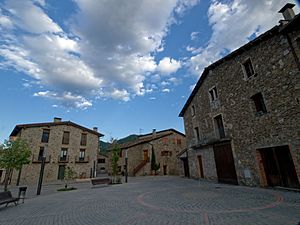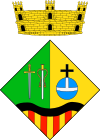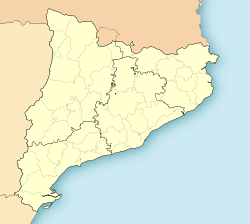La Vall de Bianya facts for kids
Quick facts for kids
La Vall de Bianya
|
|||
|---|---|---|---|
|
Municipality
|
|||

L'Hostalnou de Bianya
|
|||
|
|||
| Nickname(s):
La vall dels sentits
(The valley of the senses) |
|||
| Country | |||
| Comarca | Garrotxa | ||
| Area | |||
| • Total | 93.6 km2 (36.1 sq mi) | ||
| Elevation | 480 m (1,570 ft) | ||
| Population
(2018)
|
|||
| • Total | 1,286 | ||
| • Density | 13.739/km2 (35.58/sq mi) | ||
| Demonym(s) | Bianyenc, bianyenca | ||
La Vall de Bianya (pronounced la va-lee duh bee-an-ya) is a town in Catalonia, Spain. It's made up of eleven small villages spread across two beautiful valleys, Bianya and Bac. The main office for the town is in L'Hostalnou de Bianya. The biggest village is La Canya, which is actually split between La Vall de Bianya and another town called Sant Joan les Fonts. This area is also part of the Zona Volcànica de la Garrotxa Natural Park, a cool natural park with volcanoes!
Contents
What Does the Name "Bianya" Mean?
The name "La Vall de Bianya" means Valley of Bianya in the Catalan language. It refers to the Bianya valley, which is the most important natural area in the town.
How the Name Changed Over Time
For a long time, the name Bianya was sometimes spelled with a "B" and sometimes with a "V" (Vianya). The oldest mention of the name is from the year 958, when it was called Vallebiania. Later, it changed to Bianna (in 1117) and Bisania (in 1319), before becoming Bianya.
In the 1800s, Vianya became more common. But after the Second Spanish Republic, the spelling Bianya was used again. After Spain became a democracy, Bianya was officially chosen as the correct spelling.
Theories About the Name's Origin
No one is completely sure where the name Bianya comes from, but there are two main ideas:
- Via Annia: Some people think Vianya comes from the Latin words "Via Annia." This was the name of an ancient Roman road that went through the area. You can still visit parts of this old road today!
- Two Rivers: Another idea is that Bianya means "two rivers." This refers to the Sant Ponç d'Aulina and Santa Llúcia de Puigmal streams. These two streams join together to form the Bianya stream. This idea comes from old documents from the 1700s that called the place Bisania. "Bis" means "two" or "twice," and "ania" might come from the Latin word "amnis," meaning "river."
Exploring the Geography and Climate
La Vall de Bianya is a very mountainous area. The main feature is the Bianya valley, which gets its water from the Bianya stream. This stream is formed by two smaller streams. The valley is surrounded by different mountain ranges.
The town also includes the Bac valley, where the Oix and Castellar de la Muntanya streams begin. There's also a special part called La Canya, which is a village split between La Vall de Bianya and Sant Joan les Fonts.
Villages of La Vall de Bianya
La Vall de Bianya is the second largest town in Garrotxa by area. This is why it has so many villages! Most of these villages are spread out, often built around a church. The only villages that are more clustered together are L'Hostalnou de Bianya (the main town), La Canya (the most populated), and Llocalou.
| Villages of La Vall de Bianya | |
| La Canya | 562 inhabitants |
| Capsec | 101 |
| Castellar de la Muntanya | 12 |
| L'Hostalnou de Bianya | 105 |
| Llocalou | 175 |
| Sant Andreu de Socarrats | 46 |
| Sant Martí del Clot | 35 |
| Sant Pere Despuig | 92 |
| Sant Salvador de Bianya | 75 |
| Santa Margarida de Bianya | 77 |
| La Vall del Bac | 36 |
Local Forests and Weather
The forests in La Vall de Bianya mostly have downy oaks, holly oaks, and Scots pines. There are also large areas of pastures, covering about 7,000 hectares.
The climate here is Mediterranean, but with some colder influences. It rains quite often throughout the year, especially in spring. Temperatures are usually mild. However, it can get frosty in winter. Summer nights are cool and pleasant.
Population Over the Years
The number of people living in La Vall de Bianya has changed a lot over time. In 1717, there were 826 people. The population grew to 2,886 by 1857. After that, it slowly decreased for many years.
By 1981, the population was 1,121. Since then, it has slowly started to grow again. In 2018, there were 1,286 people living in La Vall de Bianya.
| Population census | ||||||||||||||||||||||||||||||||||||||||||||||||||||||||||||||||||||||||||||||||||||||||||||||||||||||||||
|---|---|---|---|---|---|---|---|---|---|---|---|---|---|---|---|---|---|---|---|---|---|---|---|---|---|---|---|---|---|---|---|---|---|---|---|---|---|---|---|---|---|---|---|---|---|---|---|---|---|---|---|---|---|---|---|---|---|---|---|---|---|---|---|---|---|---|---|---|---|---|---|---|---|---|---|---|---|---|---|---|---|---|---|---|---|---|---|---|---|---|---|---|---|---|---|---|---|---|---|---|---|---|---|---|---|---|
|
|
|
|
|
||||||||||||||||||||||||||||||||||||||||||||||||||||||||||||||||||||||||||||||||||||||||||||||||||||||
| Source: [1] | ||||||||||||||||||||||||||||||||||||||||||||||||||||||||||||||||||||||||||||||||||||||||||||||||||||||||||
A Look at La Vall de Bianya's History
The area of La Vall de Bianya was once part of the County of Besalú. Important families, like the Bianya family, lived here. They built the Sant Pere Despuig church, which was finished in 964. Over time, these family lands were sold to different groups.
The villages we see today mostly grew from old church areas called parishes. In 1396, King Martin the Humane added several of these parishes to the Crown of Aragon.
Earthquakes and Changes in the 1400s
In the 1400s, big earthquakes hit the Garrotxa area. Many people were hurt, and several churches in La Vall de Bianya were completely destroyed. Other churches were badly damaged.
By 1497, La Vall de Bianya had eleven parishes. Some of these parishes and the village of Les Illes (now La Canya) formed a group called the Consell General de la Vall de Bianya. This group helped manage taxes for the people living there. It was an early form of local government.
Forming the Modern Municipality
Over the centuries, smaller parishes and towns merged together. This happened because of new rules about how areas should be governed. In 1716, new laws created eight separate towns in what is now La Vall de Bianya.
In 1870, another big change happened. Six of these towns merged into Capsec. This left only two towns in the area: Sant Salvador de Bianya and Capsec. The town of Capsec was often called Vall de Bianya during the 1800s. In 1917, the name was officially changed to La Vall de Bianya, and the main town office moved to L'Hostalnou de Bianya.
The Spanish Civil War and Recovery
During the Spanish Civil War, many churches in the area were damaged. Historical documents and old records were also lost. However, some valuable items were saved. For example, an image of Santa Margarida and a Baroque altarpiece were protected.
After the war, the area slowly recovered. In the 1950s, new bridges were built, making it easier to travel between villages. In the 1960s, new housing areas were built in La Canya, Llocalou, and L'Hostalnou. A new church was also built in La Canya in 1968.
Recent Developments
La Vall de Bianya reached its current size in 1970 when Sant Salvador de Bianya merged with it. In 1973, Montserrat Reixach became the mayor. She was one of the first women in Catalonia to hold this position. Her time as mayor happened during Spain's move back to democracy.
To help people stay in the area, new housing projects began in the 1980s. In 1993, a community center was built, and the town hall was updated. In 1994, new tunnels called Capsacosta tunnels opened. These tunnels greatly improved travel between Garrotxa and Ripollès. The tunnels also led to the discovery of a natural spring. A big project started in 1996 to use this water. By 2016, the project was finished, and now 90% of the town gets its water from this natural spring!
See also
 In Spanish: Vall de Vianya para niños
In Spanish: Vall de Vianya para niños




